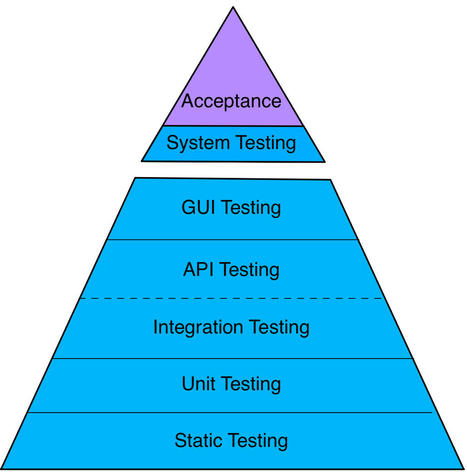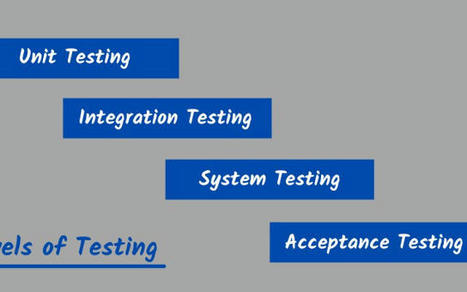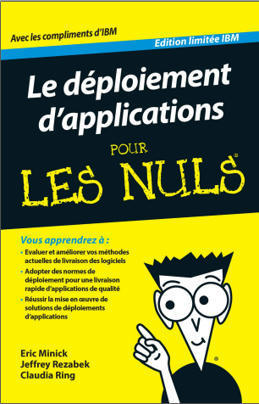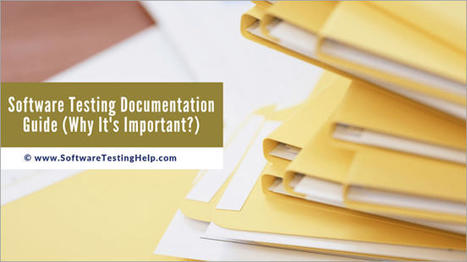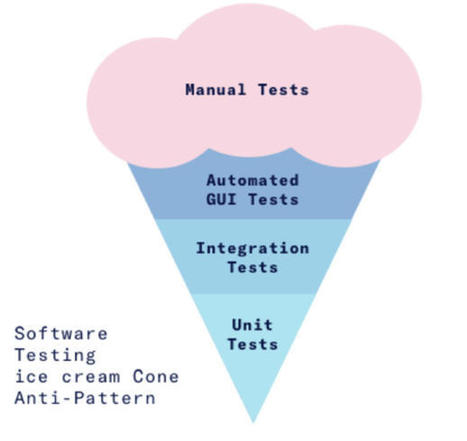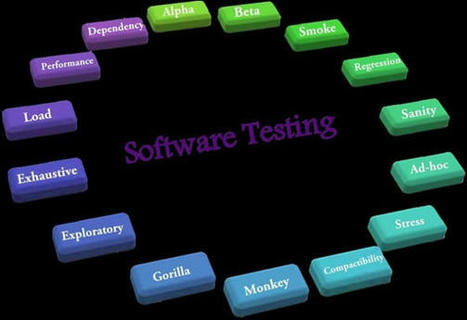 Your new post is loading...
 Your new post is loading...

|
Scooped by
Mickael Ruau
January 14, 2022 1:10 AM
|
How to balance the test pyramid?
Now that we know the main types of tests, the ideal pyramid, and all the patterns we should not follow, do we know exactly how to implement our test strategy?
No! There is no magic formula. The test pyramid is a simplistic representation of a strategy that leaves out several types of tests that may or may not apply to our project.
The goal is to stimulate reflection on teams so that we can understand what can be used and how we can improve our strategy. Focus on some Agile principles like testing early to get fast feedback, preventing bugs instead of finding bugs, and remembering that the whole team is responsible for quality. This way, you’ll have visibility into all possible improvements that need to be made to processes or techniques, and the quality of your product will gradually evolve.

|
Scooped by
Mickael Ruau
January 12, 2022 2:11 AM
|
This truth creates the need for testing before going live.
Startups and small-sized companies heavily rely on Manual Testing and their focus is on delivering the minimum viable product.
Code quality…

|
Scooped by
Mickael Ruau
January 10, 2022 1:03 AM
|
On this page, an overview of test automation pyramids can be found. The collection started as an exploration of the development of models in software testing. The test automation pyramid turned out to be a very popular model and has seen a great deal of modifications and varations since its conception by Mike Cohn in 2004.

|
Scooped by
Mickael Ruau
December 8, 2021 4:39 AM
|
Avant de lancer l’exécution de campagnes de tests pour un site internet ou une application mobile, il est nécessaire de rédiger des cas et plans de tests précis. Ce préalable, véritable fil rouge, permet d’assurer la maîtrise de la campagne de tests à mener. Pour être efficace, encore faut-il savoir bien formaliser et rédiger les

|
Scooped by
Mickael Ruau
November 24, 2021 12:29 AM
|
In this episode, we are joined by The Evil Tester as we take a deep dive into testing, and talk about the challenges that organizations commonly face with it. We take a look at the practical skills to become good testers and testing teams and also touch on topics such as Agile Testing and its relation to Agile Development, automation, and the various testing models that we see today.

|
Scooped by
Mickael Ruau
November 16, 2021 12:03 PM
|
Test Case
A test case is a set of activities that are carried out to verify the functionality of a certain component or feature of your product application. A test case is a set of test steps, test information, preconditions, and postconditions built for specific test cases to ensure that all prerequisites are met.
It's a collection of circumstances or elements. When a tester determines whether an application, programming framework, or one of its features is performing as expected.
Test Scenario
Any usefulness that can be tested is defined as a test scenario. It is a collection of tests that allows the testing group to determine the task's positive and negative characteristics. The Test Scenario gives us a good idea of what we need to test.
It also examines if the business streams are operating as intended. The setup of circumstances is the most important component of scenario testing; to do so, the situation tester must communicate with or seek assistance from the customer, partner, or designers.

|
Scooped by
Mickael Ruau
November 11, 2021 8:01 AM
|
We should write tests to enable developers to move fast with confidence. Code is always evolving, so question everything, collect experience, and judge for yourself.

|
Scooped by
Mickael Ruau
October 29, 2021 11:15 AM
|
In this article, we will look at 4 essential levels in software testing including unit testing, system testing, integration testing, and acceptance testing.

|
Scooped by
Mickael Ruau
October 26, 2021 9:32 AM
|
Suivre le cycle de vie du développement logiciel
▲
Le SDLC peut intégrer tous les aspects du cycle de vie d'une application, de la planification initiale jusqu'à son retrait de la production. Dans cette section, nous examinons une partie importante du SDLC que nous appelons le pipeline de livraison, qui est généralement composé de plusieurs environnements, c'est-à-dire des cibles de déploiement pour un ensemble d'éléments, qui travaillent ensemble à la réalisation d'un objectif commun. L'enchaînement des environnements permet d'améliorer et de vérifier la qualité d'une application avant qu'elle ne devienne accessible par les utilisateurs. Il n'y a pas un nombre idéal d'environnements, mais nous avons identifié quatre grands types d'environnements.
Développement (DEV) : dans l'environnement de Développement, les développeurs créent et déploient du code dans un laboratoire où l'application est testée au niveau le plus élémentaire. Lorsque l'application satisfait certains critères de qualité, elle passe à l'environnement suivant.
Test d'intégration système (SIT) : dans l'environnement Test d'intégration système, l'application est testée pour garantir qu'elle fonctionne avec les applications et systèmes existants. Lorsque l'application réussit les tests d'intégration, elle est déployée dans l'environnement suivant.
Test d'acceptation des utilisateurs (UAT) : dans l'environnement test d'acceptation des utilisateurs, l'application est testée pour s'assurer qu'elle fournit les fonctionnalités requises pour les utilisateurs finals. Cet environnement est généralement proche de celui de la production (voir Chapitre 4). Lorsque l'application répond à ces exigences, elle est promue vers l'environnement final.
Production (PROD) : dans l'environnement Production, l'application est mise à la disposition des utilisateurs. L'analyse du comportement utilisateur de l'application (voir l'encadré) est obtenue en surveillant la disponibilité et la fonctionnalité de l'application. Tous les mises à jour ou correctifs sont introduits dans l'environnement DEV et suivent le même cycle.
La Figure 1-1 montre un simple diagramme de ces quatre environnements.
Image non disponible
Figure 1-1 : Les quatre environnements élémentaires du SLDC
Un déploiement se définit comme la promotion de composants d'une application depuis un environnement vers le suivant. Une release comprend le déploiement de toute une application ou de plusieurs applications intégrées dans un environnement de production.
La Figure 1-2 illustre la différence.
Image non disponible
Figure 1-2 : Visualisation de la différence entre une livraison et un déploiement
Exécution d'une boucle de rétroaction
Certaines pratiques de livraison de logiciels impliquent la surveillance de l'application dans tous les environnements puis le renvoi des analyses à l'équipe de développement. En fonction des nouvelles exigences, l'équipe de développement déploie l'application modifiée dans l'environnement DEV, et le cycle démarre à nouveau. Après la promotion vers chacun des environnements successifs, l'application est supervisée, et les réactions des utilisateurs sont renvoyées à l'équipe de développement. Ce processus est connu sous le nom de boucle de rétroaction (ou feedback loop).

|
Scooped by
Mickael Ruau
October 13, 2021 5:11 AM
|
What You Will Learn:
List of Best Test Management Tools in 2021
#1) Zephyr Scale
#2) PractiTest
#3) Zephyr Squad
#4) TestCollab
#5) Requirements and Test Management for Jira (RTM)
#6) XQual
#7) Xray – Cutting Edge Test Management
#8) TestRail
#9) Kualitee
#10) TestFLO for JIRA
#11) SPIRATEST by Inflectra
#12) Qase
#13) Testpad
#14) JunoOne
#15) TestMonitor
#16) Klaros-Testmanagement
#17) QACoverage
#18) JIRA
#19) QAComplete
Additional Test Management Solutions
Conclusion
Recommended Reading

|
Scooped by
Mickael Ruau
October 13, 2021 5:11 AM
|
What You Will Learn: [hide]
Software Testing Templates
Software Testing Books
Software Testing Training
Software Testing tools and Tutorials
Videos
Software Testing Interview Preparation
Software Testing Jobs
ISTQB Study Guide
CSTE and CSQA Certification Study Guide
BFSI Domain Resources
Recommended Reading

|
Scooped by
Mickael Ruau
October 13, 2021 5:10 AM
|
What You Will Learn: [hide]
Importance of Software Testing Documentation
My Experience
Test Documentation: What’s That?
10 Tips to Help You Achieve Test Documentation Goals
Important Software Testing Documents
Conclusion
Recommended Reading

|
Scooped by
Mickael Ruau
October 13, 2021 5:08 AM
|
What You Will Learn: [hide]
Test Plan Creation – The Most Important Phase of Testing
What Is A Test Plan?
STLC Process
Test Planning At SDLC Phases
Components Of A Plan Document
Sample Test Plan Document For A Live Project
Test Planning Vs Test Execution
Test Planning
Major Components in the Planning Phase
Limitations
Test Execution Plan
Ways to Overcome Problems while Execution
Version Controlling and Management
Difference Between Test Planning & Test Execution
Recommended Reading
|

|
Scooped by
Mickael Ruau
January 13, 2022 1:08 AM
|
Ham Vocke summarises the purpose of the test automation pyramid thus:
Your best bet is to remember two things from Cohn's original test pyramid:
Write tests with different granularity
The more high-level you get the fewer tests you should have

|
Scooped by
Mickael Ruau
January 11, 2022 1:05 AM
|
We may prefer Unit and Integration tests for bad reasons
The points referred in the Agile Pyramid but focusing mainly on unit tests could be done for bad reasons. Three different typologies will be covered: Organisational, Process and Tooling.
A first reason can be related to lack of maturity or budget for test activity and test engineer allocation. It usually results with developers validating their own development, increasing the technical debt with to much unit tests.
Another reason usually mention that tests are done too late in the process, thus having low value and slowing down the whole delivery. In fact, most of time the inclusion of test from the design – also known as shift-left pattern – is not done. It is a typical factor of having tests started too late in the process.
The last one, related to tooling, miss an automated testing solution fulfilling the automation requirements: flexible configuration, fast execution and feedback loop, CI/CD ready, accessible to the whole team.
Functional and end-to-end tests usually fail due to lack of Skills, Automation & Tooling. We can reverse the point of view of the previous point, from a functional test automation perspective. The difficulties raised in the ecosystem reside in the capacity to deliver a successful test automation strategy.
In a lot of cases, the tests are partially automated, resulting in costly tests, harder to maintain over time. Other experiences usually lack trained testers and software testing competencies. The outcomes resulting in fragile tests, with manual data setting, lacking reuse, technical and design quality. This type of experience also results in a poor functional test automation experience.
Organisations also implement models that were not proven to scale or focused on the bad priority, thus increasing the tests complexity, execution time, maintenance. It usually resides in lack of design and analysis, and method selection like equivalent partitioning, boundary value analysis, decision-table testing, state transition, use-cases, … appropriated to each context. We get back to lack of proper investment and skill in the test activity.

|
Scooped by
Mickael Ruau
January 8, 2022 5:01 AM
|
La pyramide de test de Mike Cohn est sans doute l’approche le plus simple pour comprendre les différentes couches de tests et leurs proportions (ratio LoC). Si vous avez besoin de développer une application robuste et stable qui doit le rester dans le temps, investir dans une stratégie de tests est intéressante pour vous.
Cette stratégie s’adapte progressivement à vos besoins et aux spécificités de votre application. La pyramide des tests, se base sur les techniques les plus accessible pour, au fil du temps, intégrer des pratiques de plus en plus complexes à mettre en oeuvre.

|
Scooped by
Mickael Ruau
December 8, 2021 4:37 AM
|
Pour écrire un cas de test il faut que l’écriture soit standardisé, qu’elle soit sensiblement la même quel que soit le testeur qui ait écrit le cas. Il faut également que n’importe quelle personne du projet soit capable d’exécuter ce cas, l’exécution des cas de test ne doit pas être un goulot d’étranglement ni dépendre de la personne qui l’exécute (cela arrive malheureusement assez fréquemment) !
Le principe de base de toute écriture d’un cas de test manuel est :
0
C’est-à-dire que chaque étape d’un cas se définit par 1 action précise engendre 1 résultat précis.

|
Scooped by
Mickael Ruau
November 18, 2021 12:16 AM
|
The untested code gap kills productivity and predictability. We don’t choose where the bugs go making them easy to find; they choose their hiding places, and have no mercy on us. They flare up and put teams into fire fighting mode.
Are we are beat? Do we have to put up with buggy products and long test and fix cycles? No, we do not! We must accept that a product test strategy based on manual test is unsustainable. Unsustainable systems eventually collapse. We can’t afford not to automate much of your software test.

|
Scooped by
Mickael Ruau
November 11, 2021 8:43 AM
|
Key Takeaways
A software Release is always associated with Risk and benefits. Business focuses on reducing risks and cashing in on benefits.
A canary release is the same as a regular release as software is being pushed to production, even if it's to a small subset of users.
A canary release doesn't guarantee detection of all issues with a small percentage of users using it as users won't be testing the app the way testers do, or may not be using all the features at a time.
In certain domains, there is a risk of reputational damage, regulatory violations and lawsuits if a canary release were to impact the user.
Given the risk associated, having a canary release capability doesn’t rule out the requirement of an exploratory tester.

|
Scooped by
Mickael Ruau
October 29, 2021 11:37 AM
|
Who Writes Test Cases
It varies from one organization to the next. If a dedicated group or team of testers and developers is involved, it might be considered a collaborative effort.
Testers write Acceptance Tests
Developers write Unit Tests
Testers & Developers write Integration Tests
Any quality assurance tester should be able to understand and carry out the test if the test case is well-written. When developing test cases for software testing, it's crucial that they put themselves in the shoes of the customer and consider all relevant information. Investing the extra time and effort now to write good test cases will save them time and work later.

|
Scooped by
Mickael Ruau
October 28, 2021 8:05 AM
|
Les tests tout le monde connait. Parler de stratégie de test, tout le monde le fait. Cette session revient sur les fondamentaux du test et des stratégies de test, par quelqu'un qui le fait.

|
Scooped by
Mickael Ruau
October 13, 2021 5:16 AM
|
La conception des tests est la partie « intelligente » des tests. C’est celle où l’on décide à quoi vont ressembler les tests et quels seront leurs buts. L’exhaustivité des tests étant impossible il faut faire des choix et en faire des pertinents.
Il existe plusieurs techniques de conception dont de nombreuses basées sur les spécifications. Pour les découvrir je vous recommande la série de Benjamin Butel à ce sujet.
Un ALM n’est pas un outil de conception
Un ALM est un outil « presque » à tout faire pour le testeur, néanmoins il n’inclut pas de module pour concevoir ses tests. En effet, ses fonctions sont des fonctions de taxonomie, de répertorie et de suivi. Ils ne permettent malheureusement pas au testeur de savoir quels sont les tests à exécuter.
Existe t-il des outils de conception de test ?
Oui, il existe des outils de conception de test. Ces outils aident le testeurs à générer des tests en suivant diverses contraintes indiqués par celui-ci.
Les outils de conception de test les plus représentatifs sont les outils de MBT (Model Based Testing) qui se base sur des représentations graphiques des fonctionnalités de l’application.

|
Scooped by
Mickael Ruau
October 13, 2021 5:11 AM
|
What You Will Learn: [hide]
Writing A Test Strategy Document
Test Strategy
What Is A Test Strategy?
Test Strategy Vs. Test Plan
Process To Develop A Good Test Strategy Document
Common Sections Of Test Strategy Document
Step #1: Scope And Overview
Step #2: Test Approach
Step #3: Test Environment
Step #4: Testing Tools
Step #5: Release Control
Step #6: Risk Analysis
Step #7: Review And Approvals
Simple Tips To Write Test Strategy Document
Conclusion
Recommended Reading

|
Scooped by
Mickael Ruau
October 13, 2021 5:10 AM
|
What You Will Learn: [hide]
Different Types of Software Testing
#1) Alpha Testing
#2) Acceptance Testing
#3) Ad-hoc Testing
#4) Accessibility Testing
#5) Beta Testing
#6) Back-end Testing
#7) Browser Compatibility Testing
#8) Backward Compatibility Testing
#9) Black Box Testing
#10) Boundary Value Testing
#11) Branch Testing
#12) Comparison Testing
#13) Compatibility Testing
#14) Component Testing
#15) End-to-End Testing
#16) Equivalence Partitioning
#17) Example Testing
#18) Exploratory Testing
#20) Functional Testing
#21) Graphical User Interface (GUI) Testing
#22) Gorilla Testing
#23) Happy Path Testing
#24) Incremental Integration Testing
#25) Install/Uninstall Testing
#26) Integration Testing
#27) Load Testing
#28) Monkey Testing
#29) Mutation Testing
#30) Negative Testing
#31) Non-Functional Testing
#32) Performance Testing
#33) Recovery Testing
#34) Regression Testing
#35) Risk-Based Testing (RBT)
#36) Sanity Testing
#37) Security Testing
#38) Smoke Testing
#39) Static Testing
#40) Stress Testing
#41) System Testing
#42) Unit Testing
#43) Usability Testing
#44) Vulnerability Testing
#45) Volume Testing
#46) White Box Testing
Conclusion
Recommended Reading

|
Scooped by
Mickael Ruau
October 13, 2021 5:08 AM
|
Download: You Can Also Download This Sample Test Plan Template here.
We have also prepared a real Live Project Test Plan from this sample.
You can check and download it in the following tutorials:
Simple Test Plan Template
Test Plan Document (Download)
=> Visit Here For Complete Test Plan Tutorial Series
|

 Your new post is loading...
Your new post is loading...
 Your new post is loading...
Your new post is loading...






